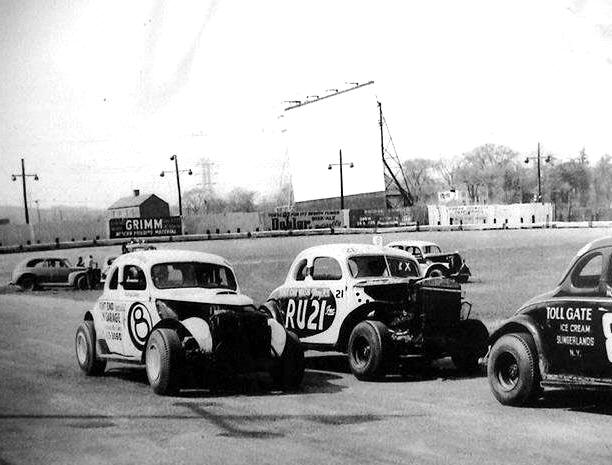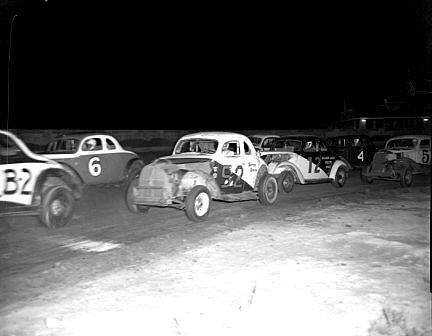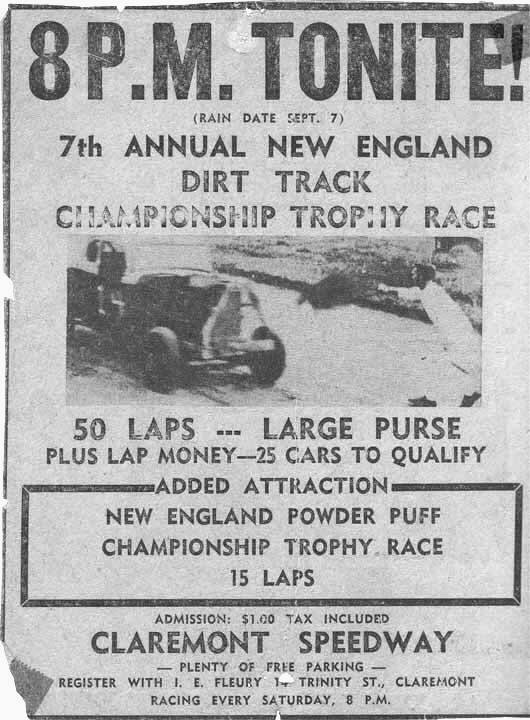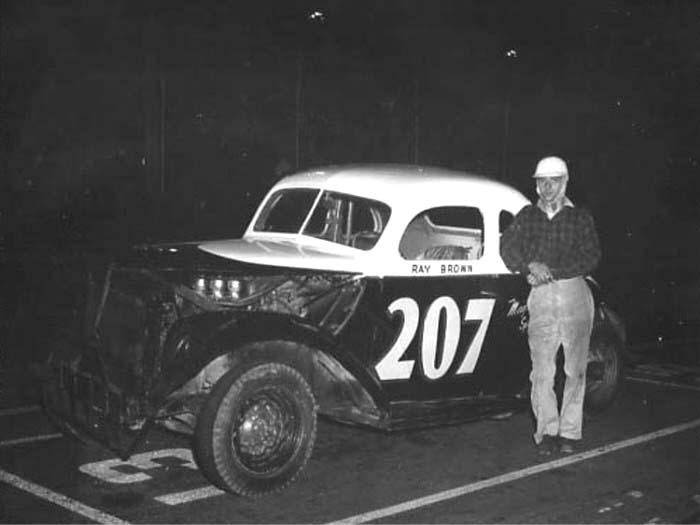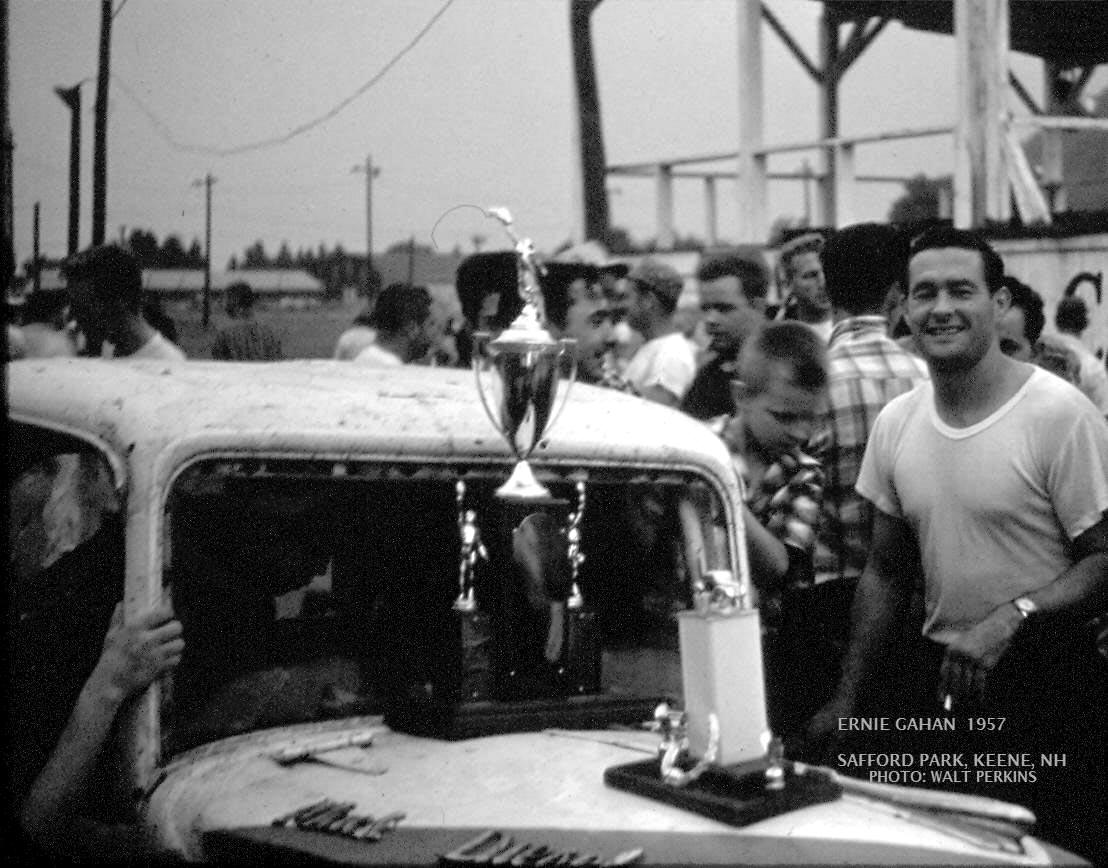|
|
Since I seem to have lost my forum, Mark
Thomas' "Racin' Paper", I will apparently enter the 21st Century and start doing
my column as a
blog. In certain times of the year, this may not be weekly; but I promise to
keep it regular. Many of the site regulars have only been able to
get my columns via this site, anyway, and representing the very newspaper that
was given out at Thunder Road gave me no press courtesies.
So, I might as well do it this way and reach some different readers. Let me know
what you think. -Bill
Week of June 24, 2012
|
|
A GROUP AHEAD OF ITS TIME
Back in the late 1940’s and early 1950’s, there were not a lot of large, comprehensive race sanctioning groups around. The American Automobile Association [AAA] had been running the open wheel world for a while and was on its way out of the racing business. That big France fellow was starting a circuit for guys running ordinary passenger cars down in Florida. The United States Auto Club was taking over for AAA; but, the burgeoning world of little stock cars [which were springing up all over much like dandelions in the spring] were pretty much on their own.
This ad in the Brattleboro Reformer, from July of 1953, pretty much says it all. The only unexplained thing is why the host track, Rhythm Inn, is not included in the hype. [Courtesy of Joe Crowley]
Almost every hole – in – the – wall race track had some sort of club governing its operation, if you want to call it that; but, there were no organizations around which encompassed multiple tracks. A group would arise in New York, that would spend a period of time trying to run a confederation of the Menands Raceways track, the Pine Bowl Speedway, and the Stateline Speedway. They would even attempt to add a fourth track – the closed Pico Raceway, in Rutland, Vermont.
Empire Raceways, the host track of the Tri- State organization, was a pavement oval in a sea of 1950’s dirt tracks. Like many others, it scarcely survived the ‘50’s. [Courtesy of Joe Grossetti]
A lesser – known but similar organization was beginning operation on the other side of Vermont, in the corner where New Hampshire, Vermont, and Massachusetts borders all meet. Much like the Tri – State group, this outfit knew that this was a potentially great area for the development of stock car tracks. Notwithstanding the closing track near Hinsdale, NH, the area promised at least four fully – functioning stock car ovals within a reasonable distance of one another.
This piece of New England map shows the apparent reason why the Triangle Racing Association chose its name. The triangle extends from Claremont, the northernmost track, west to Brattleboro and down to Rhythm Inn. Keene is in line between Keene and the Rhythm Inn location in Millers Falls, Mass.
The Triangle Racing Association, would eventually encompass the Brattleboro Speedway, West Brattleboro, VT; the Rhythm Inn Speedway, Millers Falls, MA; the Claremont Speedway [or Fleury’s Farm Speedway], Claremont, NH; and the important track at the Cheshire County Fairgrounds near Keene, NH – often referred to as Safford Park. I know little or nothing about the organization, who was in it, who its officials were, important dates, or anything else – but the tracks it affected were the development league for many stock racing superstars.
Hopefully, may be readers of this column who know something about the Triangle Racing Association will contact me and tell me what they know. All I have is an advertisement from the Brattleboro Reformer, sent to me by Joe Crowley. It is difficult to read some of the print on the ad; but it appears as though the group was headquartered in Millers Falls. It is odd because the Millers Falls track is the only one not featured in the ad.
Action at Rhythm Inn, on a Friday night in northern Massachusetts. Future national champion,
Rene Charland, is in the car 12. [Source: racersbored.com]
The advertisement, from June of 1953, gives details on big races at Claremont, on the 2nd, West Brattleboro on the 3rd, and Keene on the 4th of July. This turns out to be Thursday, Friday, and Saturday. Keep in mind two things: people were still leery of Sunday racing in some areas because of the Sunday Blue Laws flap of 1951. Also, in those days, there was no such thing as the “Monday holidays” yet. Perhaps, Rhythm Inn was planning on using Sunday – who knows ?
According to the fine print, the Cheshire Fairgrounds customarily ran on Thursday nights; Rhythm Inn had Fridays; Claremont ran on Saturday nights; and Brattleboro Speedway took Sundays [perhaps because it had no lights]. So, this holiday weekend event was a departure for all the tracks from their usual schedules.
In a partial list of early drivers from this particular region, it becomes evident quickly why the TRA was governing and developing some pretty fair talent that would go on to big careers soon thereafter. Arguably, at the top of the list, was the driver of Barney Matte’s 107 – young Rene Charland, of Holyoke, Massachusetts. Charland would tool a number of cars at the four tracks before going off to run in both the Fonda, NY area and around his home area of Agawam, MA, on his way to four straight NASCAR National Sportsman championships in the 1960’s. Charland, who is still living, although seriously ill, drove primarily in the Northeast; but, he did run several times down South – particularly in his points chase years.
I
Roy “Pappy” Forsyth spins at Safford Park in 1957 as Cecil Bosworth goes by in Stroker Smith’s 111. Forsyth would recover to win the race. [Courtesy of Walt Perkins]
Another frequent runner – particularly at Keene, was future NASCAR National Modified champion, Ernie Gahan, of Dover, NH. Having initially cut his teeth on racing in his hometown and in Maine, Gahan would run all over the Northeast, making a living at his trade and racking up NASCAR points for over a decade. Although not a national figure, Roy “Pappy” Forsyth, of Keene, NH was another superstar in the northeast, although he rarely ventured south of the New Hampshire state line.
A number of remarkable regional stars ran some or all of the TRA venues in the early to mid 1950’s. Art Rousseau, of Keene, Red Seguin of Fitchburg, MA: and Reino Tulonen, the Flying Finn also from Fitchburg, MA, were three big stars of the famous cutdowns era. The cutdowns were radically – altered coupes which were eventually outlawed due to safety issues. NASCAR modified luminaries George Janoski, Stafford Springs, CT; Buddy Krebs, of Hartford, CT; and Wally Pettengil, from Manchester, CT all started at these four rudimentary tracks.
Sonny Fleury’s poster advertises an early race program at his track, in Claremont New Hampshire. It is the only surviving former TRA track. [Courtesy of Phil Chastenay]
Northern New England stars who dominated flathead Ford racing at places like Claremont, Fairmont Speedway, in Fair Haven, VT and even as far north as Thunder Road in Barre, VT included Forsyth; Art Cody and Ted Brown, from Keene; Sonny Rabideau, from Brattleboro, VT; and Cecil Bosworth, from Athol, MA. Two early and very dominant drivers who ventured as far west as the Capitol District of New York were Fitchburg’s Ray Brown, and Ed Cormie, from Greenfield, MA. Legendary car owner Marty Harty, from Salisbury, MA and future Thunder Road star Tony Colicchio, of Walpole started out with the TRA.
Cars fly through turns three and four at Brattleboro Speedway around 1954. Sonny Rabideau [7] leads the car he would become famous driving in the 1960’s - Stroker Smith’s 311, then piloted by Cecil Bosworth. Check out the children in the foreground – great safety practices ! [Courtesy of Joe Crowley]
The tracks, themselves, varied in importance and longevity. The track at the Cheshire Fairgrounds, simply known to most racing people in the area as “Keene”, was one of the most important tracks in the northeast, in terms of the development of the sport, from what could have been a dying – out, flash – in – the – pan sort of fad to a lasting activity that wove into the economic and sports fabric of most areas in the nation. The half – mile dirt horse track ran in 1953 before it was shortened to one third mile and called Safford Park. It gave way, around 1961, to the rapidly – developing Claremont Speedway.
Claremont began as Fleury’s farm Speedway, established by Sonny Fleury. It first looked a lot like racing in a sand pit, with the Fleury family upgrading the Claremont Jalopy Drivers organization into a top notch modified venue by the 1970’s. Now called Twin State Speedway, the track has struggled in the past few years; but, in its heyday, Claremont drivers went out, especially into Vermont, and dominated wherever they went. Brown, Rabideau, Cody, Bardwell, Miller, and others are names known to anyone who watched the flathead Ford action in the 1960’s.
Ray Brown, shown here with a car that also raced at a number of Connecticut and Massachusetts tracks, was one of the TRA’s consistent star attractions. [Source Unknown]
Rhythm Inn was a unique arrangement – and the only Massachusetts track in the bunch. Named for the road house which existed on the property before its inception, the track ran throughout the entire decade of the 1950’s. Like so many other tracks, it closed after the 1959 season. Ed Cormie and Ray Brown were two of the track’s top performers. If it was like others of that era, the drivers might have been paid up at the road house, whereby they would then have spent much of their winnings – right back to the owner.
The West Brattleboro venue was, by far, the most rustic of the four. Here, a lineup on the log-lined front stretch shows Art Rousseau [621], Buddy Bardwell [white coupe at far left],Joe Ryan, and Ray Harris [37]. [Courtesy of Lew Boyd]
Brattleboro Speedway [known simply as West Brattleboro to most] ran from 1950 to 1955. It never developed much of an infrastructure, but it shared in that rich pool of drivers that was attracted especially to Keen and Claremont. Brattleboro seemed to also gain cars from Massachusetts – perhaps because of its Sunday schedule. It was the first of the TRA tracks to close, leaving the other three to make it through most of the decade.
If one is called upon to justify my placing a lot of importance on the existence of the Triangle Racing Association and its four tracks – simply consider a lineup for a feature with the following drivers in the field: Rene Charland, Lionel Arel, Sonny Rabideau, Buddy Krebs, Art Cody, Mike Cody, Buddy Bardwell, Ted Brown, Ray Brown, Ed Cormie, Art Rousseau, Reino Tulonen, Paul Martell, Ernie Gahan, Wally Pettengil, Red Seguin, Harold Hanaford, Roland LaPierre, Ed Patnode, Cecil Bosworth, George Janoski, Joe Ryan, and Pappy Forsyth – and you would not have covered all the talent that was often available for TRA races. Nuf sed.
Future NASCAR National Modified Champion, Ernie Gahan, poses in Victory
Lane at Safford Park around 1957. [Walt Perkins Photo]Please email me if you have any photos to lend me or information and corrections I could benefit from. Please do not submit anything you are not willing to allow me to use on my website - and thanks. Email is: wladabou@comcast.net . For those who still don’t like computers - my regular address is: Bill Ladabouche, 23 York Street, Swanton, Vermont 05488.
Return to the Main Page
Return to the Main News Page
Return to the All Links Page
Return to the Weekly Blog Links Page
